Director name: Wang Tianyi
Credits: Hong Yao
Neon signage, which originated in Paris in the 1910s, uses different gases such as helium, neon, argon, krypton, or xenon to achieve colorful lighting effects. In the 1920s, Hong Kong began installing neon signs on Tang buildings to attract customers. Hong Kong’s unique combination of high-density buildings, narrow streets, and “living on top” architecture allows neon signs to extend from the walls to the road, forming a spectacular streetscape. In the 1980s, when Hong Kong’s economy was booming, the number of neon signages on the streets reached its peak, and the promotion of Hong Kong films made neon signages an iconic cityscape.
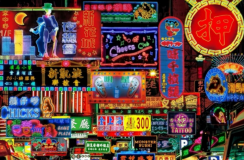
Fig.1.1. Photograph from HKFP Lens: Photographer Keith Macgregor pays tribute to Hong Kong’s colorful, neon-drenched past
However, as the production process moved north and the rise of more cost-effective LED lights, neon signages gradually declined. In 2008, the government moved to remove abandoned signboards across Hong Kong after an incident led to accusations of poor oversight. In 2010, a “Minor Works Supervision system” was implemented, requiring unapproved or illegal billboards to be removed. In addition, high rents and the pandemic have also led to the closure of some shops with famous signs. More than 16,000 advertising signs have been removed or restored in the past five years, including many landmark neon signs.
Although neon signages are foreign, the traditions of Chinese signs have been preserved and incorporated into the visual language of local neon signs. This kind of sign enlarges the size, spans the space, and better reflects the changing urban texture and architectural characteristics.
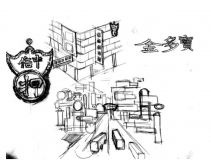

Fig.1.2 Sketches of classical layout of signages in Hong Kong on the street (left), and a font commonly used on billboards (right).
In terms of location, I mainly chose Mong Kok and Central for shooting, because Mong Kok still retains some neon elements and urban texture of old Hong Kong, while Central, with the development of The Times, shows the diversity of different shops through modern lamps and billboards.

Fig.1.3 The allocation of neon signages in Hong Kong, from Google Map (2014)
Since the whole video is focused on recalling the past and looking forward to the future, I divide the video into two styles: nostalgia and modern. For nostalgia, I used the Charge-coupled Device and doubled the speed to create a slow, neon-lit blur of old Hong Kong. Secondly, I used the push and pull lens to focus the billboard, thereby shifting the audience’s attention from the street to the billboard itself, emphasizing its importance and increasing the motion and drama of the picture. At the same time, this kind of hand-held photography can increase the sense of movement and reality of the lens, so that the audience is closer to the scene. I also adjusted the camera Angle to convey different visual effects. In the middle of the video, there was an overhead shot. I was standing on the overpass in Mong Kok to shoot people walking below, in order to reflect the movement and interaction of people under the lights.
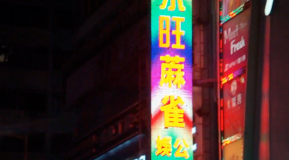
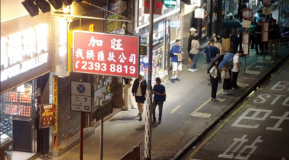
Fig.1.4 A magnification of the neon signage (left), the overhead shot of people passing by the signage (right)
In terms of the transition to the future, I use the empty mirror of people coming and going to emphasize the development of the environment (city) and the passage of time. Meanwhile, there is also a shot including both the neon signage and LED signage to emphasize the comparison. I shot the rest with a clear phone lens. In one of the scenes, I shot standing on an elevator in Central, I used panning to change the viewer’s perspective. At the same time, the city will be more stable from this perspective, which also highlights that the development of the city is continuing to move towards stability and prosperity.
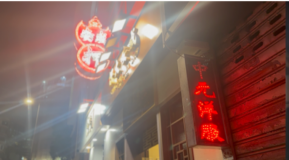
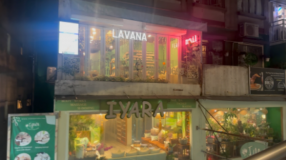
Fig.1.5 A comparison between neon signage and LED signage (left), the current signage in Central (right)
For video dubbing, I asked someone who had worked in Hong Kong in the 1990s. Let he tell the story from the first perspective and set off the change of people’s ideas in the future pursuit of urban development. Of course, I also retained part of the sound of cars flowing in the street and the sound of traffic lights to highlight the bustling and busy city.
In general, through camera movement, close-ups, empty mirrors, contrast, and other shooting techniques, we can highlight the neon elements of Hong Kong’s urban development. These techniques capture the beauty and uniqueness of neon lights while highlighting Hong Kong’s development and transformation as an international city.
Bibliography
Chan, P. K. (2014). Preface: What is Neon? [序言:何解霓虹?].
In NEONSIGNS.HK (Ed.), 探索霓虹 [NEONSIGNS.HK]. Retrieved from https://www.neonsigns.hk
Clark, D. B. (1997). The cinematic city. London: Routledge.
Google. (2014). Mapping the Prevalence of Neon Signs in Hong Kong [Data file]. Retrieved from https://www.neonsigns.hk/neon-in-visual-culture/why-neon-signs/
HKFP Lens. (2018, October 13). HKFP Lens: Photographer Keith Macgregor pays tribute to Hong Kong’s colorful, neon-drenched past. Hong Kong Free Press HKFP. Retrieved from https://hongkongfp.com/2018/10/13/hkfp-lens-keith-macgregor-pays-colourful-tribute-hong-kongs-bygone-eras/.
Sze-hang Kwok, B., & Coppoolse, A. (2018). Hong Kong skins: signs and screens in a changing cityscape. Visual Communication (London, England), 17(1), 71–90. https://doi.org/10.1177/1470357217723210
Patent Issued for Neon-Free Illuminated Signage. (2018). In Electronics Newsweekly (pp. 4435-). NewsRX LLC.
郭斯恆. (2018). 霓虹黯色: 香港街道視覺文化記錄.
探索霓虹 [NEONSIGNS.HK]. (n.d.). Retrieved from https://www.neonsigns.hk
邱益彰. (2019). 香港道路探索 : 路牌標誌x交通設計 = Hong Kong road study : signage & highway design (初版.). 非凡出版.
鄭昶權. (2009). Discovering Signs a Study of cantilever Neon Signage as a Post-war Urban Vernacular Heritage of Hong Kong [Thesis (M. Sc.) –University of Hong Kong, 2009.]. https://doi.org/10.5353/th_b4796686